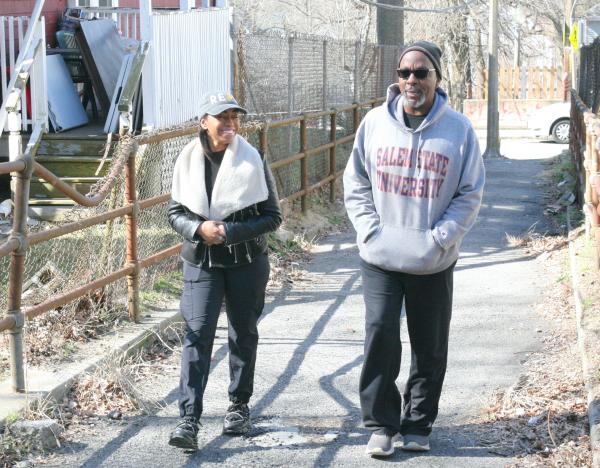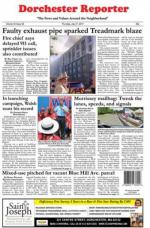April 12, 2023

Wellington Hill neighbors Jei Christie and Aamir Mahdi took a stroll this week on one of the stretches of the Wellington Hill footpaths between Hazelton and Wellington Hill streets. The paths, believed to be original to the neighborhood, are in dire need of restoration and improvement.
Every city neighborhood has its charms. For its part, Mattapan’s Wellington Hill has its walking paths.
Like those of Beacon Hill or Mission Hill, the city-owned paths through the hilly Mattapan neighborhood go back to when the pastoral landscape was in the early stages of becoming a residential area some 125 years ago.
With long streets laid out in a circular fashion on a steep hill, the paths were likely as utilitarian as they were quaint as residents traversed between streets without having to walk around them.
They still offer that convenience, and remain an amenity that residents cherish, although they would like to see them fixed up. City officials indicated a major renovation project is likely coming this summer, but residents note it’s been a long-time coming and they’d like to go beyond maintenance and also make them a showpiece.
A short footpath between Wellington Hill/Duke Streets and the former Solomon Lewenberg School (now Young Achievers) is well used by students and families headed to the school or the top of the hill, with its generous views of downtown Boston.
“When you walk, you look at things in slow motion, but in a car, things go by fast and you can’t observe and see the beauty of the neighborhood,” said Aamir Mahdi, of the Wellington Hill Neighborhood Association. “The footpath is a great way to get from Wellington Hill to Walk Hill and then down to Almont Park. It just adds so much to the neighborhood and gives it a little bit of a country environment in the middle of the city.”
He added, “It’s also easy for the residents to go from one street to the other without having to go all the way to the end and back up.”
For other neighbors like Jei Christie, an association member, the paths were the clincher for her choosing to live on the Hill. The Hyde Park native said she was looking to buy a home in Roxbury, but while checking out a home on Wellington Hill, she took a walk along the paths.
“After that I knew it was to be here,” she said. “I actually had my first date with my spouse on these paths,” she said. “I had just moved here and wanted to show off the paths and we walked them for our date. It has an intimacy to it. When the lights are on, they add to the ambience.
A part of the path from Westmore to Erroll Streets has been blocked off completely, while the upper part is being used as a parking lot for apartments.
“A lot of people don’t know about [the Hill], and it’s a hidden gem,” she continued. “I’ve never had a person that said it wasn’t cool after I showed it to them. It’s our crème de la crème.”
There are five pieces to the pathways, but some of them are so run-down that they are either closed off or have been taken over illicitly. They include:
• A stretch of wooded walking path between Walk Hill and Hazelton streets, which has been closed by the city due safety concerns caused by years of neglect.
• A section between Hazelton and Wellington Hill that boasts decorative lighting and a wide but deteriorated path.
• A piece from Wellington Hill/Duke Streets to the former Solomon Lewenberg School (now called Young Achievers Academy) that is handy for schoolkids.
• A long but minimalist path between Wellington Hill and Westmore Street that is only a sidewalk’s width and has no lighting or décor.
• A final piece that has become a parking lot for abutting multi-family homes and is blocked off at its descent to Erroll Street. It is intended to connect to Harvard Street and the Boston State Hospital property.
From histories of Wellington Hill done by the Boston Landmarks Commission, it can be surmised that the paths were part of the neighborhood’s original design. While much of the surrounding area had been developed long before, Wellington Hill remained “upland pasture” even after 1900 due to its steep incline. Part of the property was inherited by a Harvard University graduate student ,Wellington Holbrook, who sold off lots for residential development. The Goodale and Lawrence families sold off the rest of the residential land as Wellington Hill Park.
A long, wooded stretch of the Wellington Hill footpaths is blocked off between Walk Hill and Hazelton streets due to a lack of maintenance and unsafe conditions. Many on Walk Hill Street report feeling like outcasts since the closure.
Together, they drew street layouts and promised to have them in place by 1910, likely when the walking paths were also laid out. Construction company stamps can still be observed in the concrete paths from 1912 and 1915.
By the 1920s, Wellington Hill was a thriving neighborhood of blue-collar and white-collar workers, with the Lewenberg School opening in 1930.
It appears that many of the paths haven’t had serious work on them since the original concrete layout, with crumbling concrete, broken railings, and inaccessible sections.
City Engineer Para Jayasinghe, who shares the love of the Wellington Hill footpaths, said records indicate they were completed in 1915. He noted that many pathways are deteriorated or shut down, but the hope is that things will soon change.
“We are on track to advertise a project for the replacement of the closed staircase and make improvements to the footpath that is open and give it a facelift to make it what the community deserves,” he said.
He said if bids come in as expected, which are hoped to be under $1 million, they will start construction this summer and have an opening around Labor Day.
“Like the neighbors, I find these paths very endearing,” he said. “People actually meet and come together on these footpaths and they enliven these neighborhoods. I cherish them as the community does.”
Mahdi said they are excited to see the improvements delivered this summer, but most residents would like to see the city go an extra step beyond maintenance. Some, like David Lopes, have called for the paths to be more of a priority in neighborhood planning initiatives like PLAN Mattapan.
“Let’s improve things already there like the Wellington Hill footpaths,” he said last fall during a PLAN Mattapan session, run by the Boston Planning and Development Agency (BPDA).
All three neighbors hope that one day restored footpaths will be hosting things like public art, neighborhood block parties, and other activities like those scheduled for the Beacon Hill footpaths.
“It’s interesting how something so different and unique can make you want to spend your life here and it makes me think we need more walking paths,” said Jei Christie. “When you’re driving, you’re not paying attention to people. You don’t stop in a car, but when you’re walking you may stop and maybe it sparks a conversation, and you learn about your neighbors.”
Villages:



